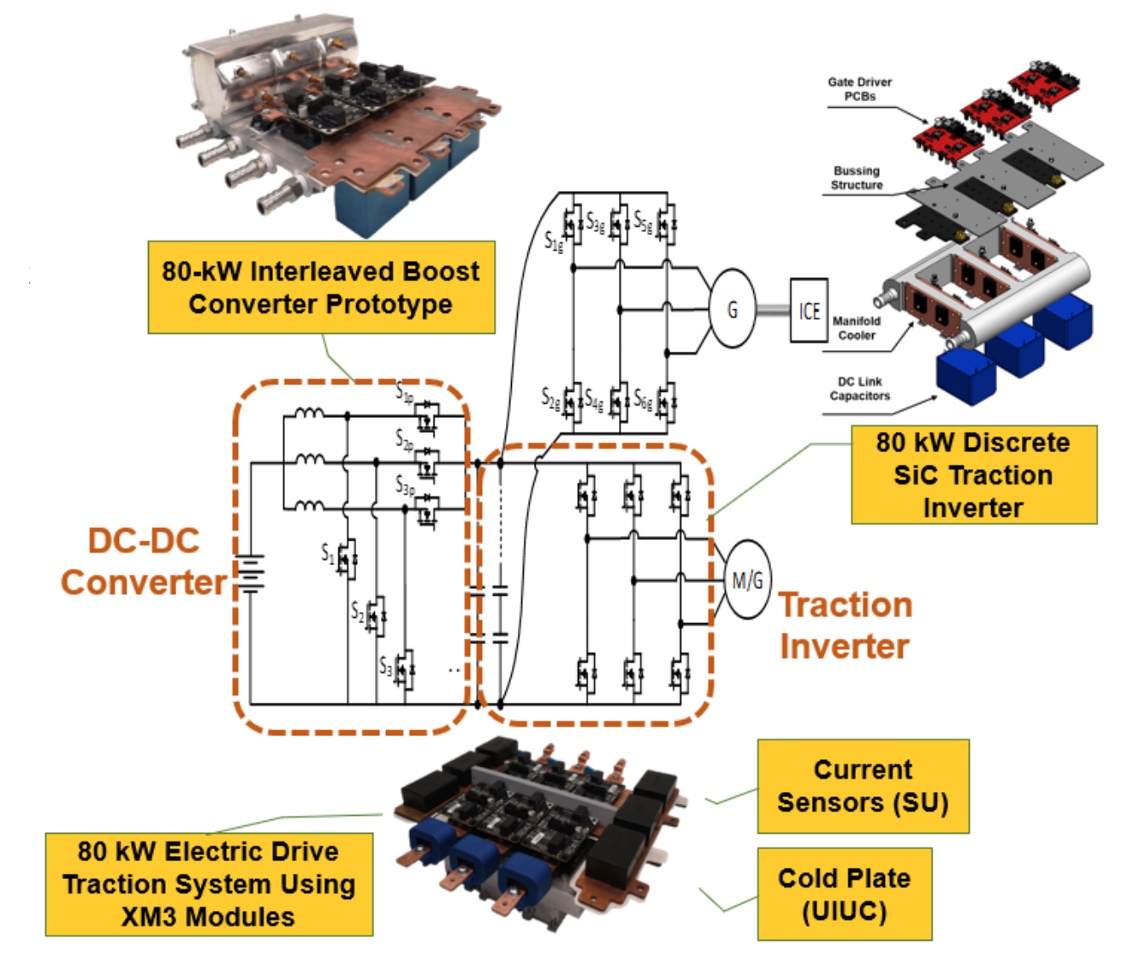POETS Researchers Develop a Power Dense (50 kW/L) Electric Drive Traction System
Outcome/Accomplishment
A team of researchers at the Power Optimization of Electro-Thermal Systems (NSF POETS) Engineering Research Center (ERC) have developed an innovative power dense electric drive traction system (EDTS) having both a three-phase interleaved boost converter and a traction inverter and an additively manufactured (AM) cold plate. The EDTS achieved power density of 55.6 kilowatts per liter (kW/L). The work, completed at the University of Arkansas (UA), the University of Illinois at Urbana-Champaign (UIUC), and Stanford University (SU), is funded by the U.S. National Science Foundation (NSF).
Impact/Benefits
Electric traction systems often require additional equipment for braking and control, which drives up equipment costs and footprint. The EDTS developed by NSF POETS features a co-design electro-thermal methodology that enhances performance and power density. By leveraging a unique traction inverter based on discrete semiconductor devices, the NSF POETS design brings cost and size reductions that will enable greater affordability and safety for electric mobility. The traction inverter alone achieved a power density of 155 kW/L.
Explanation/Background
An 80 kW EDTS was designed using XM3 Modules, a gallium nitride (GaN)-based current sensor developed at SU for traction applications, and an AM cold plate. The design features a direct current (DC) to DC converter paired with an 80 kW silicon carbide (SiC) traction inverter. The DC-DC converter is built with an interleaved boost converter prototype. The traction inverter is a soft-switched unidirectional inverter developed by UA researchers. XM3 modules were used to optimize performance of the SiC in a simple but robust design. The team observed that by minimizing the root mean square (rms) current of the common DC-link capacitor in the EDTS via its control algorithms (UA), a power dense system could be enabled. The research team includes two doctoral students at UA, one doctoral student at UIUC and two doctoral students at SU in the field of electric vehicles.
Location
Urbana-Champaign, Illinoiswebsite
Start Year
Microelectronics and IT
Microelectronics, Sensing, and IT
Lead Institution
Core Partners
Fact Sheet
Outcome/Accomplishment
A team of researchers at the Power Optimization of Electro-Thermal Systems (NSF POETS) Engineering Research Center (ERC) have developed an innovative power dense electric drive traction system (EDTS) having both a three-phase interleaved boost converter and a traction inverter and an additively manufactured (AM) cold plate. The EDTS achieved power density of 55.6 kilowatts per liter (kW/L). The work, completed at the University of Arkansas (UA), the University of Illinois at Urbana-Champaign (UIUC), and Stanford University (SU), is funded by the U.S. National Science Foundation (NSF).
Location
Urbana-Champaign, Illinoiswebsite
Start Year
Microelectronics and IT
Microelectronics, Sensing, and IT
Lead Institution
Core Partners
Fact Sheet
Impact/benefits
Electric traction systems often require additional equipment for braking and control, which drives up equipment costs and footprint. The EDTS developed by NSF POETS features a co-design electro-thermal methodology that enhances performance and power density. By leveraging a unique traction inverter based on discrete semiconductor devices, the NSF POETS design brings cost and size reductions that will enable greater affordability and safety for electric mobility. The traction inverter alone achieved a power density of 155 kW/L.
Explanation/Background
An 80 kW EDTS was designed using XM3 Modules, a gallium nitride (GaN)-based current sensor developed at SU for traction applications, and an AM cold plate. The design features a direct current (DC) to DC converter paired with an 80 kW silicon carbide (SiC) traction inverter. The DC-DC converter is built with an interleaved boost converter prototype. The traction inverter is a soft-switched unidirectional inverter developed by UA researchers. XM3 modules were used to optimize performance of the SiC in a simple but robust design. The team observed that by minimizing the root mean square (rms) current of the common DC-link capacitor in the EDTS via its control algorithms (UA), a power dense system could be enabled. The research team includes two doctoral students at UA, one doctoral student at UIUC and two doctoral students at SU in the field of electric vehicles.

